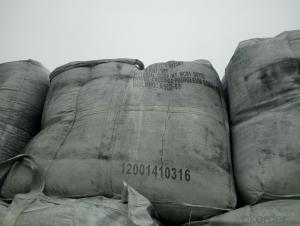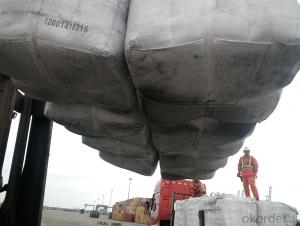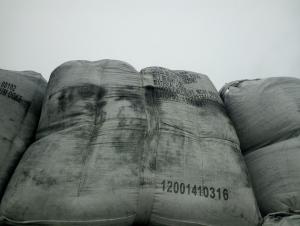Calcined Pitch Coke with Ash 0.5%max for Steel Companys
- Loading Port:
- Tianjin
- Payment Terms:
- TT OR LC
- Min Order Qty:
- 28 m.t.
- Supply Capability:
- 8000 m.t./month
OKorder Service Pledge
OKorder Financial Service
You Might Also Like
Introduction
Pitch Coke/Coal Tar Pitch is a kind of black brittleness and blocky piece, lustrously at normal temperature. It has special odour and poisonous and can be easily flame when melting, second-grade inflammable solid.
Pitch Coke/Coal Tar Pitch is obtained from powerfully processed coal tar. Compared to petroleum asphalt, the adhesiveness is better. Coal Tar Pitch is high quality tar production with high fixed carbon. It has excellent adhesion, waterproofing and resistance against seawater, oil and various chemicals. In these properties, it is much better than petroleum asphalt tar.
It can be used to produce painting, electrode, pitch coke, and tar felt. It also can be used as fuel and the raw material of asphalt carbon black.
Features:
The morphology, chemistry and crystallinity of recarburisers have a major impact on the overall casting cost. The combined application and cost benefits, which are derived through the use of Desulco, enable foundries to manufacture castings in a highly cost effective manner.
reduces
Recarburiser consumption
Power consumption
Inoculant consumption
MgFeSi consumption
Furnace refractory wear
Scrap rate
Tap to tap time
Slag inclusions risk
Chill
increases
Casting microstructure
Productivity
Process consistency
Carbon Recovery
Compared with calcined petroleum coke, acetylene coke and
graphite electrode scrap, Desulco yields the highest carbon
recovery and fastest dissolution time
Specifications:
CPC | |||
F.C.% | 98.5MIN | 98.5MIN | 98MIN |
ASH % | 0.8MAX | 0.8MAX | 1MAX |
V.M.% | 0.7 MAX | 0.7 MAX | 1 MAX |
SULFUR % | 0. 5MAX | 0. 7MAX | 1MAX |
MOISTURE % | 0.5MAX | 0.5MAX | 1MAX |
Pictures:

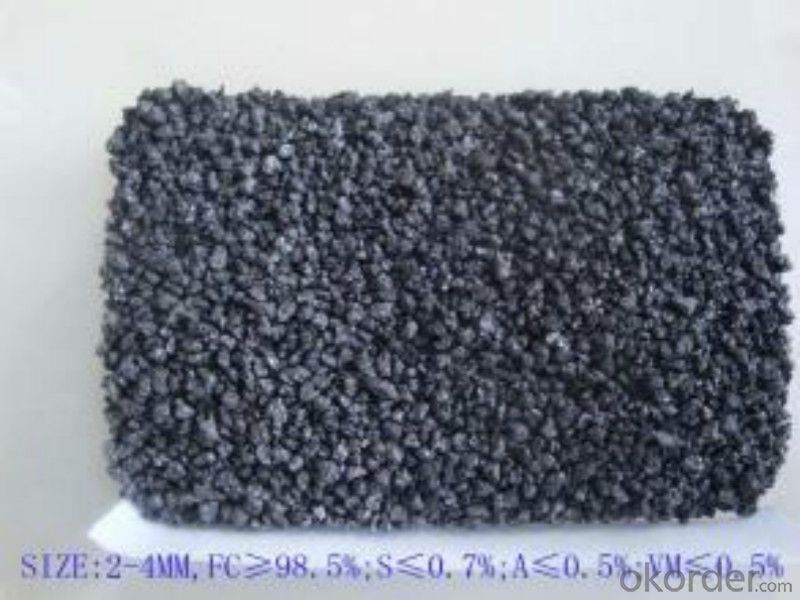

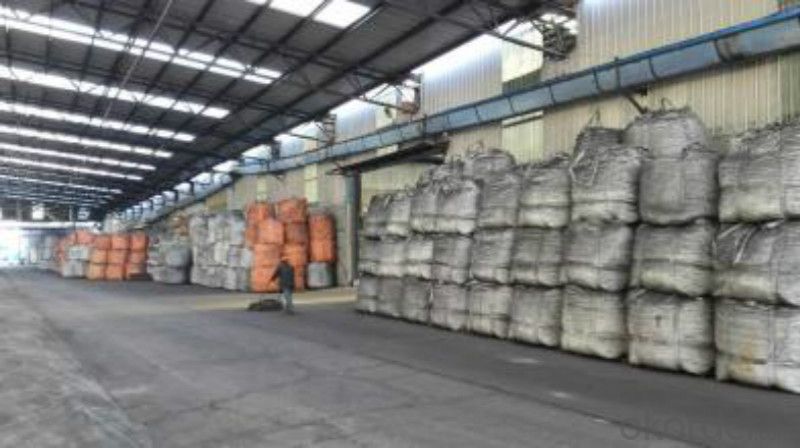
FAQ:
1.MOQ:2 Containers |
2.Size:1-3mm,1-5mm,2-6mm,3-5mm and as the customer's requirement |
3.Packing: 1 ton jumbo bag or 25kgs paper in bag |
4.Payment:T/T or L/C at sight |
5.Delivery time: within 15 days after receiving the deposit |
6.Usage: it is as carbon raiser,widely used in steelmaking,casting,casting iron,steel foundry,aluminum metallury. |
- Q: What are the different types of carbon fibers?
- There are several different types of carbon fibers, each with its own unique characteristics and properties. Some of the most common types include: 1. PAN-based carbon fibers: These are the most commonly used carbon fibers and are made from polyacrylonitrile (PAN) precursor materials. They offer a good balance between strength, stiffness, and cost-effectiveness. 2. Pitch-based carbon fibers: These fibers are made from coal tar pitch or petroleum pitch precursor materials. They typically have a higher density and higher thermal conductivity compared to PAN-based fibers, making them suitable for applications requiring high thermal stability. 3. Rayon-based carbon fibers: These fibers are produced from regenerated cellulose, commonly known as rayon. They have a lower modulus and strength compared to PAN-based fibers but offer excellent electrical conductivity and are often used in applications such as conductive textiles and electrical components. 4. Mesophase pitch-based carbon fibers: These fibers are made from a liquid crystalline precursor material called mesophase pitch. They have a high modulus and excellent thermal conductivity, making them ideal for applications requiring high strength and heat resistance, such as aerospace and automotive industries. 5. Vapor-grown carbon fibers (VGCFs): These fibers are produced by the chemical vapor deposition (CVD) method. They have a unique tubular structure and high aspect ratio, offering exceptional mechanical and electrical properties. VGCFs are often used in advanced composite materials and nanotechnology applications. It is important to note that the choice of carbon fiber type depends on the specific requirements of the application, such as mechanical strength, thermal stability, electrical conductivity, or cost-effectiveness.
- Q: What are the properties of carbon fibers?
- Carbon fibers are a unique and versatile material with several notable properties. One of their most significant properties is their exceptional strength-to-weight ratio. Carbon fibers are incredibly strong, often surpassing the strength of steel, while also being significantly lighter. This property makes carbon fibers ideal for applications where high strength and low weight are crucial, such as aerospace and automotive industries. Another important property of carbon fibers is their stiffness. They exhibit high stiffness, which means they have minimal deformation under applied loads. This property is beneficial in applications where rigidity and stability are required, such as in the construction of sporting goods like tennis rackets or golf clubs. Carbon fibers also possess excellent chemical resistance. They are highly resistant to chemical corrosion, making them suitable for use in harsh environments where exposure to chemicals or corrosive substances is a concern. This property makes carbon fibers a preferred choice for applications in the chemical industry or offshore structures. Furthermore, carbon fibers have a low thermal expansion coefficient, meaning they do not expand significantly when exposed to heat. This property makes them useful in applications where thermal stability is crucial, such as in the manufacturing of high-temperature components like turbine blades or heat shields. Additionally, carbon fibers exhibit excellent fatigue resistance, allowing them to withstand repeated loading and unloading cycles without significant damage. This property is particularly advantageous in applications subjected to cyclic or dynamic stresses, such as in the construction of sports equipment or aerospace structures. Lastly, carbon fibers have excellent electrical conductivity. They can conduct electricity efficiently, making them suitable for applications where electrical conductivity is required, such as in the aerospace industry for lightning strike protection or in the manufacture of electronic devices. Overall, the properties of carbon fibers, including their high strength-to-weight ratio, stiffness, chemical resistance, low thermal expansion, fatigue resistance, and electrical conductivity, make them a highly desirable and sought-after material in various industries.
- Q: What are the consequences of increased carbon emissions on urban areas?
- Increased carbon emissions have significant consequences on urban areas. One of the most notable impacts is the exacerbation of air pollution. Carbon emissions, particularly from vehicles and industrial activities, contribute to the release of harmful pollutants such as nitrogen oxides and particulate matter. These pollutants can lead to respiratory problems, exacerbate existing health conditions, and increase the risk of lung cancer and cardiovascular diseases among urban residents. Furthermore, increased carbon emissions contribute to the phenomenon of urban heat islands. Carbon dioxide and other greenhouse gases trap heat in the atmosphere, leading to rising temperatures in urban areas. This effect is particularly pronounced due to the abundance of concrete and asphalt surfaces that absorb and radiate heat. As a result, urban areas experience higher temperatures than surrounding rural areas, exacerbating the discomfort and health risks associated with heat stress, especially for vulnerable populations such as the elderly and those with limited access to cooling resources. The consequences of increased carbon emissions on urban areas also extend to the natural environment. Urban green spaces and ecosystems are negatively impacted as higher levels of carbon dioxide can disrupt plant growth and reduce biodiversity. This further exacerbates the loss of natural habitats and the degradation of urban ecosystems, leading to a decrease in the provision of ecosystem services such as air purification, temperature regulation, and stormwater management. In addition to the environmental and health impacts, increased carbon emissions also have economic consequences for urban areas. The cost of mitigating and adapting to climate change-induced challenges, such as flooding and extreme weather events, increases as carbon emissions rise. This puts a strain on local governments' budgets and can lead to higher taxes or reduced funding for other essential services. To address these consequences, it is crucial for urban areas to implement strategies that reduce carbon emissions and promote sustainability. This includes investing in public transportation, encouraging the use of renewable energy sources, promoting energy-efficient buildings, and implementing policies to reduce vehicle emissions. By taking these measures, urban areas can mitigate the negative consequences of increased carbon emissions and create healthier, more sustainable environments for their residents.
- Q: What are the effects of carbon emissions on the stability of estuaries?
- Carbon emissions have significant effects on the stability of estuaries. Increased carbon dioxide in the atmosphere leads to ocean acidification, which negatively impacts the delicate balance of estuarine ecosystems. Acidic waters can harm the growth and survival of estuarine plants and animals, disrupt the food web, and reduce biodiversity. Additionally, carbon emissions contribute to global warming, leading to rising sea levels and increased storm intensity, which can cause erosion and flooding in estuaries. Overall, carbon emissions pose a threat to the stability and health of estuaries, with potentially far-reaching ecological consequences.
- Q: Why vegetarianism can reduce carbon emissions?
- That is to say, when the level of the food chain is more, the carbon emissions are more natural; while the human eating vegetarian diet is the shortest food chain, which has the least carbon emissions
- Q: There are ten carbon and oil Gulu chorus, carbon English Gollum and finally he said to sing, this is English this is the song of English is what?
- You don't know, because oil Gollum and formal cooperation should be only the first, the other tracks are the max of others
- Q: What is the atomic number of carbon?
- Carbon has an atomic number of 6.
- Q: What role does carbon play in photosynthesis?
- Carbon plays a crucial role in photosynthesis as it is the primary element used by plants to produce organic compounds. During photosynthesis, plants absorb carbon dioxide from the atmosphere and use it to synthesize glucose, a simple sugar that serves as a building block for more complex carbohydrates, such as starch and cellulose. This process occurs in the chloroplasts of plant cells, specifically in the stroma of the chloroplast, where the enzyme RuBisCO catalyzes the fixation of carbon dioxide into an organic molecule called PGA (phosphoglycerate). Through a series of reactions known as the Calvin cycle, PGA is converted into glucose, which can be stored for energy or used for growth and reproduction. In summary, carbon is essential for photosynthesis as it provides the raw material necessary for plants to produce their own food and sustain life.
- Q: Organic matter is converted from organic carbon. Why is humus represented by carbon instead of converted?
- Therefore, only there is a certain relationship between soil carbon content and soil organic matter, high carbon content of soil humus certain, but it does not explain the soil organic matter, because organic matter contains not only the humus, also contains many other organic substances are not decomposed.
- Q: What are the effects of carbon emissions on the stability of grasslands?
- Carbon emissions have a significant impact on the stability of grasslands. One of the main effects is the alteration of the climate, specifically through the greenhouse effect. Carbon dioxide (CO2) is a major greenhouse gas, and the increased concentration of CO2 in the atmosphere leads to global warming. This rise in temperature affects grasslands by altering their natural growth patterns and disrupting the delicate balance of their ecosystems. Higher temperatures caused by carbon emissions can lead to increased evaporation rates, resulting in drier soil conditions. Grasslands are adapted to specific moisture levels, and any changes in these conditions can lead to reduced plant growth and increased susceptibility to drought. As a consequence, grasslands become less stable and more prone to desertification. Moreover, elevated levels of carbon dioxide can affect the nutritional quality of grasses. As CO2 concentrations increase, the relative proportion of essential nutrients in grasses may decrease. This phenomenon, known as nutrient dilution, can impact the health and productivity of herbivores that rely on these grasslands for sustenance. The decline in nutritional value can disrupt the delicate balance of predator-prey relationships and lead to a decline in biodiversity. Additionally, carbon emissions contribute to the acidification of soils. Increased carbon dioxide dissolves in rainwater, forming carbonic acid, which lowers the pH of the soil. Grasses are sensitive to changes in soil pH, and acidification can negatively affect their growth and nutrient uptake. Acidic soil conditions can also lead to the loss of important microorganisms that contribute to a healthy soil ecosystem, further destabilizing grasslands. Lastly, carbon emissions have indirect effects on grasslands through climate change-induced alterations in precipitation patterns. Changes in rainfall patterns can lead to shifts in plant composition and distribution, favoring invasive species or altering the competitive balance between different grass species. This can disrupt the stability and functioning of grassland ecosystems. In conclusion, carbon emissions have numerous detrimental effects on the stability of grasslands. These include changes in climate, increased vulnerability to drought, nutrient dilution, soil acidification, and alterations in precipitation patterns. It is crucial to reduce carbon emissions and mitigate the impacts of climate change to preserve the stability and integrity of grassland ecosystems.
Send your message to us
Calcined Pitch Coke with Ash 0.5%max for Steel Companys
- Loading Port:
- Tianjin
- Payment Terms:
- TT OR LC
- Min Order Qty:
- 28 m.t.
- Supply Capability:
- 8000 m.t./month
OKorder Service Pledge
OKorder Financial Service
Similar products
Hot products
Hot Searches















